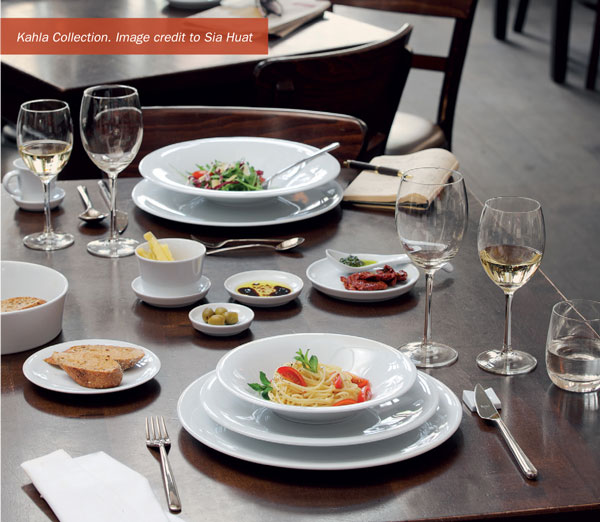
Table setting plays a big par t in a full service dining concept; it is the first thing that diners see upon sitting down and will set up an anticipation for what’s to come. Here are the general guidelines on setting the formal dinner table (although methods may differ depending on location). The most elaborate table can include up to 20 pieces of dinner ware for just one guest thus order of arrangement and details are important.

Tabletop:Symmetry begins from the tabletop arrangement and to ensure consistency, use a ruler to measure the distance between the edge of the table and the dinner ware. Of course it is only logical that the tablecloth is wrinklefree. Seams should be facing down while the amount of overhang must be the same on each side of the table.

Direction:Generally, flatware is set outside of the dinner plate to the inside to follow the progression of the meal. Follow a clockwise direction, star ting with wine and water glasses, spoons, knives,charger (also known as entree plates) and dinner plates with the napkin placed on top, dinner forks, bread plate and butter knife, and ending with the dessert spoon and dessert fork. As menus differ, there may be specialty utensils like seafood forks, snail tongs, or cups and saucers if hot beverage will be served after the meal.

Glasses:To each drink its own glass and usually comprises a glass for water, white wine, red wine, champagne which can be swapped for other glasses according to drink type paired with the food menu. Arrange them in a diagonal or square pattern to the right of the dinner plate.
Utensils:Having numerous sets of cutlery does not mean arranging them all at once. To avoid tight spaces, most restaurants do not put more than 3 utensils on either side of the dinner plate at a time and reset when diners finish the course using the last set of utensils. However, an exception for seafood/oyster fork is allowed when placed next to the last spoon on the right of the plate. Make sure that knives’ blades face the plate.

Small Details:Meticulous defines fine dining especially things that diners might not even notice. This include aligning the lower edges of the utensils with the bottom rim of the plate, about 1 inch up from the edge of the table and laying a utensil about 1 inch away from the plate’s side so that it is not hidden under the rim of a plate or bowl. It is also a 1 inch space when placing the water glass from the tip of the dinner knife. Comfort is also paramount thus elbow room should be a minimum of 15 inches between place settings or 24 inches from the centre
of one place setting to the middle of the next. With the “rules”of setting a table in check, next we look at the purpose of each piece of utensil and tableware; alongside some items deemed vital for chefs.










